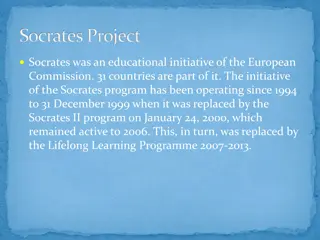Managing Disruptive Students in European Secondary Education
Disruptive behavior among students poses a significant challenge in secondary education across Europe, impacting the learning environment and teacher effectiveness. Polls reveal the prevalence of student misbehavior, prompting the need for action to maintain school peace, discipline, and uphold laws. Various measures such as removal, suspension, and expulsion are considered to address disruptive students, with decision-making processes varying by country.
Uploaded on Nov 27, 2024 | 0 Views
Download Presentation

Please find below an Image/Link to download the presentation.
The content on the website is provided AS IS for your information and personal use only. It may not be sold, licensed, or shared on other websites without obtaining consent from the author. Download presentation by click this link. If you encounter any issues during the download, it is possible that the publisher has removed the file from their server.
E N D
Presentation Transcript
Taking action against disruptive students in secondary education an European view Antwerp summer school 2010 Prof. Paul Zoontjens (Netherlands) p.j.j.zoontjens@uvt.nl
What is meant by disruptive? A student who is disturbing the educational process by Behaving violently / badly in school Having behaved very violently / badly outside school Demonstrating learning difficulties Proving to be unsuitable for the education offered Being unlawfully enrolled in school
Global overview OECD Polling teachers in 23 countries: Student misbehaviour disrupts lessons in 3 schools out of 5 3/4 of lower-secondary school teachers say their lessons are disturbed to some extent or a lot 1/3 of teachers complain about turning up late for class, profanity and swearing and intimidation or verbal abuse of others On average teachers spend 13% of their time to maintain order in classroom. In Brazil + Malaysia it is 17%. In Bulgaria, Estonia, Poland + Lithuania less than 10%
Motives for action School peace School discipline Protection (other) students and/or teachers in the school Precaution Upholding laws
Possible measures Directed towards individuals, not collectivities Internal measures and measures with external effect, for instance: > Removal from / transfer to another class > Exclusion / rustication > Suspension > Expulsion from school > Expulsion from educational system
Who takes the measures? Germany: teachers conference Netherlands / Flanders: governing body United Kingdom: school principal United States: governing body or school principal (depending on jurisdiction) Scandinavia (S,N,F): no expulsion during compulsory education Austria: district school council (s.c.) (compulsory ed.) / federal state s s.c. Portugal / Germany: Minister of ed. / Chief Schools Inspectorate expulsion from school system / (only temporarily)
Decision making process [1] Germany: 1. prior announcement of intention to expel, 2. opportunity for pupil and parents to make representations 3. written motivated decision after consent of School Inspectorate and under guarantee of admittance another similar school United Kingdom: 1. decision of exclusion, 2. duty to inform pupil or his parents about a. period and b. reason of exclusion and c. possibility and means to make representations to governing body, 3. duty to inform local education authority and governing body about reasons and period
Decision making process [2] Netherlands: 1. only exclusion after having heard pupil and his parents, 2. decision after consultation of Inspectorate, 3. duty to inform Inspectorate about exclusion, 4. guarantee of admittance another similar school Flanders (Belgium): 1. hearing of pupil and parents before taking decision, 2. decision after having obtained the advice of teachers 3. decision motivated and made known to persons involved in writing, 4. if decision has been taken before 30 June of the school year: continuation of enrolment until admittance to another school is possible
Judicial review? Dependant on difference between public and private education; focus on (semi-) public system Germany / Netherlands: complaint procedure at competent authority, administrative court United Kingdom: independent appeal panel, no judicial review (?) Belgium (Flanders): appeal against definitive expulsion at instance which is indicated in school code, judicial review
Sources of applicable law Act of Parliament Regulations / directives central government Regulations / directives regional or local government Codes of conduct > Sector regulation > School regulation > Contract?
Case 1: Armbands to protest Some students of a high school and junior high school protested against their country s presence in Iraq by wearing black armbands. This protest had been announced three weeks before it took place. The school officials had adopted a policy banning the wearing of armbands two days before the students action. When the students wore the armbands to school they were sent at home and suspended until they returned without them. The students claimed that their rights to free speech were violated by the schools action. How do you judge the schools action?
Case 2: Stripper in class room A pupil's mother had ordered an agency to give her son a "surprise" on his 16th birthday - and the teacher had even agreed to film the practical joke in class. But it all went wrong when the agency sent a stripper dressed as a policewoman instead of a "gorillagram . A witness told reporters: "She asked the lad to stand up and told him he had been a very naughty boy because he hadn't been doing his homework. Then she put on some Britney Spears music and walked the boy round the classroom while spanking him with a whip (Sky News Nov. 07). Do you find reason to suspend the pupil?
Case 3: Profanity on internet On an internet-site, made by his classmate, Peter P. published a text in which his teacher Maths was the object of displeasure. Go to hell Mrs. T.! , he wrote. And: we all have to save the earth and our future from this pernicious virus. That s why I ask everybody to inform others so that we can wipe out this horrible creature . And: how can we be released from this ugly, whisky-drinking, useless female pig? Can the school take: > a. disciplinary action against Peter P.? > b. measures to close the site?
Case 4: Hollywood copycats Looking at the results of the test paper on geography the teacher finds that the answers of Scarlett J. and Angelina J. on questions 4 and 5 (the tests holds 5 questions in total) are exactly the same. Not only the good elements but also the mistakes are in words identical. The teacher concludes that one of the girls has copied from the other and that the other has given the opportunity to copy. Both acts are serious offences. Therefore, the teacher finds that both girls have to be expelled from Hollywood high school. Do you agree with the teacher s opinion?
Case 5: Svetlanas father Svetlana B. was sent out of class because her mobile (phone) had gone off during the lesson. In a desperate mood she went at home and informed her parents. About what he heard Svetlana s father got very angry and decided to take action. With a huge axe he entered school. When he saw the responsible teacher, he approached him aggressively while flourishing the weapon and said: this is the last time that you have spotted my daughter, any next time I will kill you and some of your colleagues too! If so, what measures can the school take?
Case 6: Dealing drugs in Lima The janitor of Lima high school sees from his workplace that across the street Fernando R., who is from the sixth class and who is accompanied by Miguel P. from the third class, deals drugs with two guys from somewhere else. Fernando delivers a small package and collects a small pile of Peruvian Nuevo Sols. The janitor informs the principal, who acts firmly. He contacts the judicial authorities about Fernando s behaviour and suspends him. Miguel is also suspended in anticipation of any expulsion. Do you agree with the measures taken against F. and M. respectively?
Case 7: Lazy + absent Gennadiy Gennadiy K. has stayed for five years as a pupil at Kreschatik high school. With trouble he has reached the third class. At the end of the year, the teachers fear that Gennadiy has to double the third class, because his results are poor. Gennadiy has also proved to be a lazy pupil who you often can find in the streets of Kiev during lesson time. Finally, the teachers want him to be sent away from school. Gennadiy's parents however, make objections, stating that their son is a pupil with special educational needs (SEN), which are insufficiently recognized by school. Who is right in your opinion?
Case 8: Smart + disabled Karim Karim is in the age of 15 and physically and mentally disabled. He sits in a wheel chair. He can hardly control his moves and he cannot talk. Nevertheless, according to psychological reports Karim s IQ is rather high. His parents succeeded to enrol him on Sadiki College in Tunis. The board of Sadiki said that it only wanted to accept Karim under the condition that teaching him was doable for the school. After six months the school expels Karim: it does not have the sources and means to meet Karim s SEN. How do you judge the school s decision?
Case 9: Moot court Read the case carefully. Decide to what group you want to belong: plaintiff, defendant or court. You can belong to one group only. As far as possible, each group consists of the same number of participants. Each group has 45 minutes to prepare its role. We use another 45 minutes to have session. The court has 20 minutes to reach a sentence. Evaluation.























